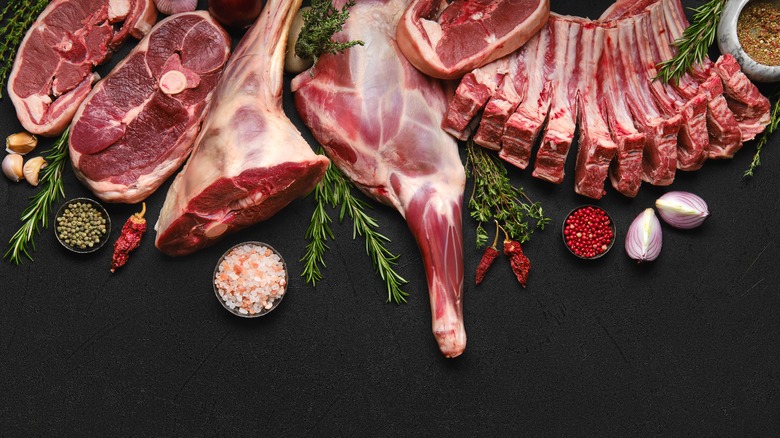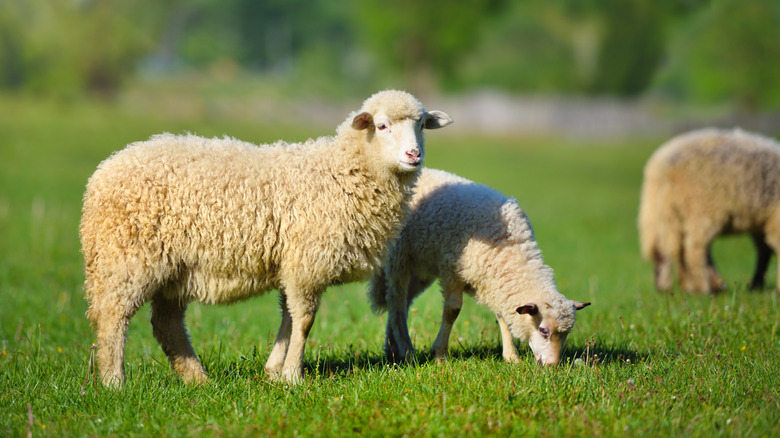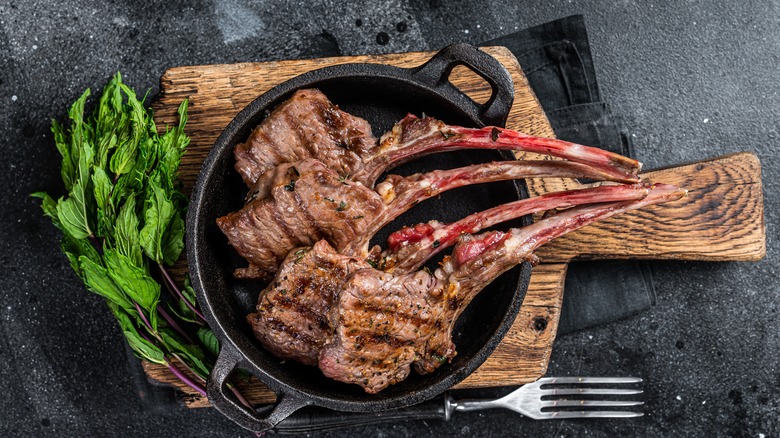What You Need To Know About Where Your Lamb Comes From
Lamb is a tender red meat that's exceptionally high in protein, healthy fats (especially conjugated linoleic acid), and essential amino acids, with impressive amounts of vitamin B12, minerals, and antioxidants (via Healthline). But as with many types of meat, reading lamb labels means learning some lingo. But first, let's remove the wool that might have been pulled over your eyes. The lamb you buy, or order in restaurants, generally comes from lambs that are under a year old, often between six and eight months old (per U.S. Department of Agriculture).
By that time, the lamb weighs in at around 140 pounds and up to 50 pounds of that is retainable meat. The mature lambs, called mutton, are sufficiently developed at eight to 12 months in terms of musculature and bone structure, per Homestead Wisconsin, which states that they are not baby lambs.
The USDA also explains that the term "spring lamb" indicates that the lamb was butchered between March and October, again, not a baby lamb (per Britannica), but meaning a specialty product that's not widely available. Also sold as hothouse or milk-fed lamb, baby lamb refers to the meat of animals between six to 10 weeks old that weigh up to 30 pounds, New York Magazine notes, and are considered an Easter and Passover delicacy.
A lambs diet and where it comes from
Now, let's have a look at the different kinds of lamb you'll see at a store, butcher, or farmer's market. The word "natural" simply means the product doesn't contain any synthetic additives of any kind and has only been lightly processed, like chopped or ground (per USDA). The other label terms will indicate what the animal ate and where it was raised. "Grass-fed" means that aside from milk, the lamb consumed nothing but grass and other pasture plants for its lifetime, while grain-fed means the animal was given a supplemented formula of ground corn, barley, sorghum, or wheat. "Finished" defines what the animal was fed during the final stages of its life before slaughter and this can be either grass or grain.
Different countries and operations raise their lambs in different ways, which ultimately affects the eating qualities of the meat. According to Cook's Illustrated, domestic (American) lamb is typically grain-finished, meaning the animal was grown to maturity on feedlot grain, versus grass-finished lamb that was strictly pastured (per USDA). Cook's Illustrated reports that American lamb is bigger and mellower, even sweeter, in flavor due to the way the grain increases fat in the meat. Imported lamb (from Australia or New Zealand) is grass-fed and grass-finished and is known to have a stronger, more "gamey" flavor commonly associated with this protein.
Other lamb shopping and cooking tips
New York Magazine reports that New Zealand lamb cuts will be light-colored, smaller, and more intensely flavored than larger, sweeter Australian lamb. Cook's Country says you can temper the rich taste of imported lamb by trimming the fat. Worth noting: While the USDA explains that while all lamb meat is inspected, it's not required to be graded for quality and that the nutritional values are consistent throughout the grades and countries of origin. The USDA adds that FDA-approved growth hormones and antibiotics are allowed in lamb rearing, so if this concerns you, seek out USDA-certified organic lamb (per Consumer Reports). Find lamb in large supermarkets or at the butcher counter, or buy it directly from farms in both the U.S. and Australia or New Zealand, where there are more sheep than people (via Entegra).
So how do you cook lamb? A roast leg of lamb is economical, and fatty lamb shoulder, like in Jamie Oliver's Middle Eastern-inspired recipe, stays nice and moist throughout long cooking. Don't forget the rosemary! Ground lamb is perfect for kebabs, while succulent shanks will put your slow cooker to good use, too. There's also Gordon Ramsay's decadent herb-crusted rack of lamb to wow your guests. Whether you like your lamb sweet and mild or bold and meaty, there are countless delicious choices out there for you to discover.


